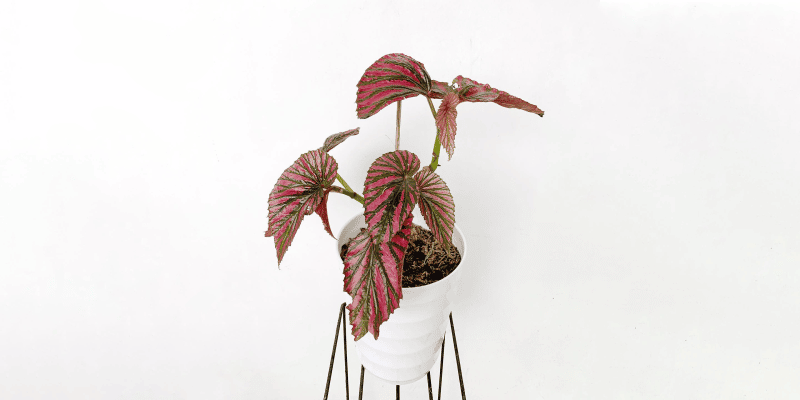Rex Begonia have some of the most vibrant colors (the entire rainbow!) and showy foliage of all begonias. It’s almost as if they were hand-painted with watercolors.
According to the American Begonia Society, there are over 4,100 cultivars, and more are developed each year. Which to choose? Where did they all come from, anyway? Maybe most importantly, how to make sure they love the environment you put them in?
The good news is, this plant may look fancy, but Begonia rex care isn’t hard at all. We’ll help you sort through the many Rex begonias so you can find one to call your own (and propagate more, too!)
Table of Contents
Rex Begonia Care Guide
History, habitat, and characteristics
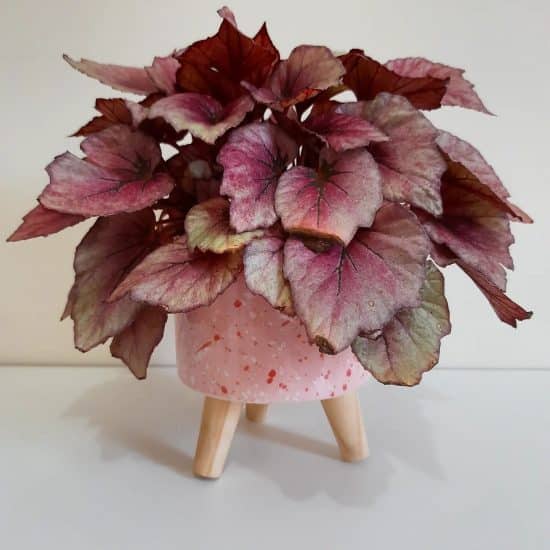
Begonia rex is a rhizomatous perennial belonging to the Begoniaceae family. The name Begonia rex-cultorum refers to all cultivated rex begonias (they all contain B. rex, a wild species, in their lineage). The plant is so colorful and comes in so many different varieties that it’s earned the nicknames painted-leaf begonia, fancy-leaf begonia, and king begonia.
Speaking of nicknames, the name rex comes from the Latin word meaning “king” or “royal,” and it’s easy to see why. Each leaf on a rex begonia is like a miniature masterpiece, some with a symphony of colors radiating outward from the center like a sunburst. Many of them have won the Royal Horticultural Society’s Award of Garden Merit.
And the begonia part of the name? In 1690, a botanist monk named Charles Plumier discovered a delicate flower in the West Indies (in the Antilles, specifically). He named it “Begonia” after a French public official he met there, Michel Begon, an avid plant collector himself.
“Begonias have been accused of many things, but no one calls them boring,” Tovah Martin wrote in a 1996 New York Times article. It’s true. Rex begonias grow in rock valleys, forests, and slopes in their original habitat. Some are terrestrial, meaning they grow on the ground, while other begonias are epiphytic and climb trees or other surfaces as they grow.
Let’s talk leaves.
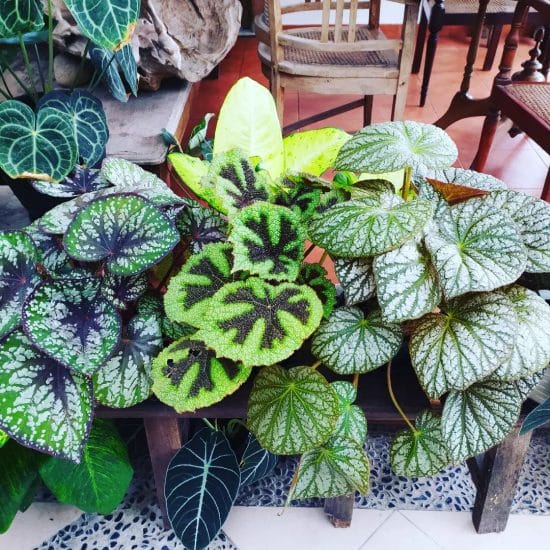
Rex Begonia’s foliage is extremely diverse. Each leaf is truly one-of-a-kind, sporting variegations in a wide mix of colors, from green and silver, to red, to purple and pink. You name the color scheme, and there’s a Begonia rex that has it.
Depending on the variety, the leaves can have a wide range of shapes, such as cordifolia (heart-shaped), reticulata (net-like veins), fissifolia (splitting leaves) and roseifolia (rose-shaped leaves). Leaves range in size up to twelve by eight inches.
Some Begonia rex are aggressive bloomers, with small one-inch pink, white or yellow flowers, but the leaves are the main attraction here.
Varieties
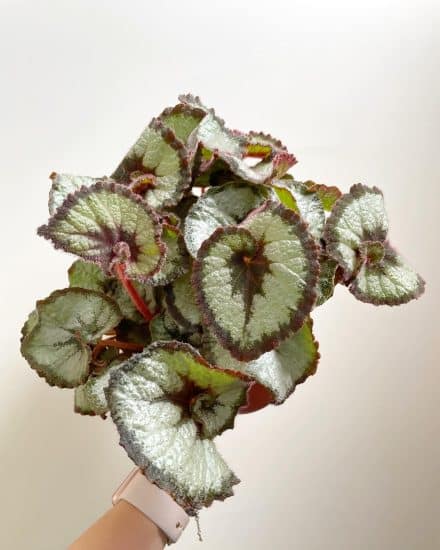
Because there are so many stunning Rex Begonia cultivars, I’ve restrained myself and listed only some of the most popular and my personal favorites.
- Angel Wing Begonias – sometimes confused for a Rex begonia (but actually considered a cane begonia), this lovely plant puts out wing-shaped leaves dotted with silver circles and can produce red flowers. (Some varieties have different-colored dots).
- Begonia rex ‘Escargot’ has a dark green center surrounded by spiraling silver and green curves, while their undersides are usually a vibrant red.
- Begonia rex ‘Fireworks’ sports silvery foliage with red veins and yellow centers.
- Begonia rex ‘Flamenco’ boasts smaller greenish-silver leaves with silver-green leaves with red and green veins.
- Begonia rex ‘Froggy’ exhibits a unique black net-like cover over green and bronze leaves with a reptilian appearance.
- Begonia rex ‘Salsa’ has silver leaves with red-burgundy and green shades.
And that’s not even half of them! The Iron Cross Begonia, the Spitfire Begonia . . . I could go on and on. There are more coming out every year, so keep an eye out and let us know what you find.
(For even more Begonias, check out our full guide!)
Did you know: Every two years, the city of Brussels in Belgium builds a Flower Carpet in its central square, Grand-Palace, out of begonias and dahlias, along with bark and grass. It takes 100 volunteers less than six hours to create it, and the carpet stretches to about 230 feet long by 79 feet wide. That’s 5,512 square feet of flowers!
All hail the King Begonia!
Light
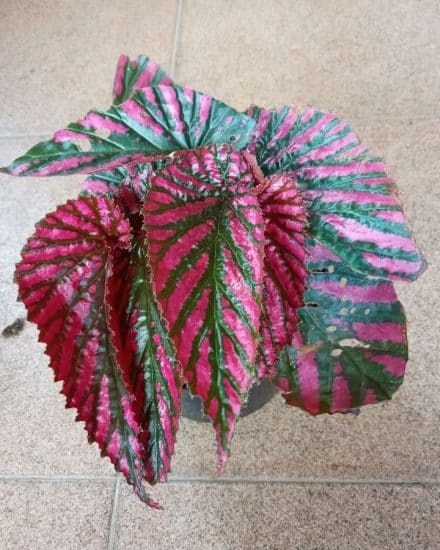
The Begonia rex is a semi-tropical houseplant and needs plenty of bright, indirect light to thrive. Put it in front of north and east-facing windows, since they receive enough indirect sunlight for your plant’s needs. Place it at least three to five feet away from a south or west-facing exposure, since these windows let in direct bright light, which can scorch the Rex begonia’s leaves.
It’s also important to rotate the plant occasionally so that all sides are receiving adequate sun exposure. If the Begonia rex doesn’t get enough light, its leaves will become pale and brittle with fewer visible veins, and its edges might curl.
Too much light and the leaves will become yellowed and leathery, and stretch out toward the sun (this is called etiolating). If this is the case, you’ll need to move the plant either further away (for instance, from a south-facing window) or closer (to, say, a north-facing window), depending on the amount and type of light it gets.
If your home doesn’t receive enough light in general, artificial lighting like an LED lamp specifically designed for plants may also be a good supplemental option. Just be sure to keep LED or fluorescent lights at least a few inches away from your plant to prevent leaf burn.
Water
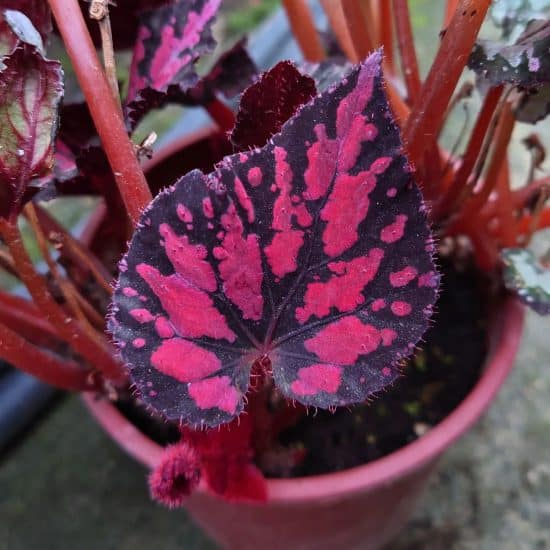
Much like a person, your Rex Begonia needs the right balance of water to keep it healthy and thriving! Ideally, your plant should be watered when the top two inches of soil feels dry to the touch. That way, you’ll avoid the twin dangers of under and over-watering. Too much water leads to root rot, while too little will cause wilting. You want moist soil, but not pools of H20.
Following the soil touch method, during warm weather, aim to water your Rex every one or two weeks. During cooler months, you can stretch the time between waterings to two or three weeks. Just be sure to go back to the regular schedule when spring arrives and the temperature rises!
You can use tap water, but if you have access to distilled water, filtered, or even rainwater, this is the better option, since it prevents chemical buildup in the soil. Whichever type of water you use, aim for the soil directly and avoid the foliage to prevent potential leaf rot.
To ensure your Rex begonias receive just enough water, you can use a moisture meter to measure the levels of moisture in the soil. You can also use visual indicators such as the plant’s weight and soil color.
Temperature and humidity
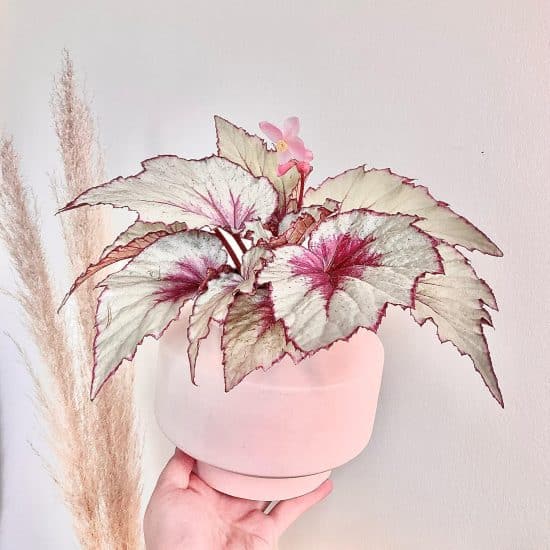
To mimic the Begonia rex’s normal habitat, its environment needs normal household temperatures—not too hot, not too cold, and the perfect balance of humidity.
Temperature: An ideal temperature range for your Begonia Rex is between 65 and 75 degrees Fahrenheit. While they can tolerate cool temperatures as low as 55 degrees, try your best to keep the temp higher. A sudden dip in temperature can cause leaves to wilt, and anything above 75 degrees F could cause your Begonia Rex to become stressed as well. Keep it away from drafty windows and radiators!
Humidity: Rex begonias live in the subtropics, so moderate to high humidity is important for them. They dislike dry air and thrive when relative humidity levels are somewhere between 45-60%. You don’t want to go much higher than this, because you’ll feel uncomfortable and your plant might gain some unwelcome visitors like fungus or mildew.
To achieve this humidity level:
- Use a humidifier.
- Employ the pebble tray method. Simply fill a tray of flat pebbles with water and place your Rex begonia plant on top. The water will slowly evaporate and put extra moisture in the air, keeping your plant happy. I like to use the pebble tray method for most of my houseplants.
- Group plants together so they can share humidity.
Don’t mist your Begonia rex, as its leaves are prone to mildew, and this will do more harm than good.
Soil and planting
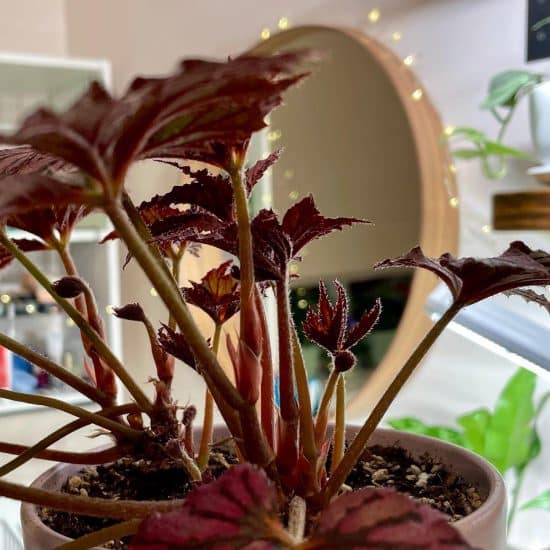
Caring for this beautiful houseplant starts with the right planting mix. To create an ideal potting mix, use:
- 50% Potting soil: Provides a base layer of nutrition, structure, and aeration.
- 25% Peat moss: Creates a light and porous texture and helps the soil retain moisture.
- 15% Perlite, orchid bark, or coco coir: Improves drainage and maintains the soil’s airy texture.
- 10% Vermiculite: Stores water and nutrients your plant can use.
You can experiment with the percentages or amend this combination with other ingredients like horticultural charcoal or pumice to adjust the pH level, drainage, and other factors. As long as the mix drains well and remains moist but not soggy, it’s a winner.
Fertilizing
A light to moderate amount of fertilizer can help your Rex begonia grow. Fertilize it regularly with a balanced liquid houseplant food once a month during the spring and summer. Take a break during the winter months when its growth slows down since your plant won’t be able to uptake the nutrients then and the extra fertilizer could burn it.
Pruning
The vast majority of Rex begonias don’t need to be pruned. The exception is if you have dead leaves, an upright cultivar, or the rhizome is too long and has bare areas. In this case, simply cut back the rhizome. (You can propagate the cut piece if you like!) This will encourage it to make new leaves and branch out.
Hot [Leaf] Tip: If you want to encourage more branching, pinch leaf tips as early as you can. You can even try out propagation from leaf cuttings!
Repotting
Repot your Begonia rex every few years, once you notice roots have filled up all the space in the pot. Choose a wide, shallow pot with good drainage holes and plenty of room to grow, as they’re relatively fast-growing (and rhizomatous plants, so they grow horizontally!). Select a container that’s 1 to 2 inches wider than the one it was in before.
We’ve gone over the main environmental care requirements your Rex begonia has, so now let’s learn how easy it is to propagate!
Propagation guide
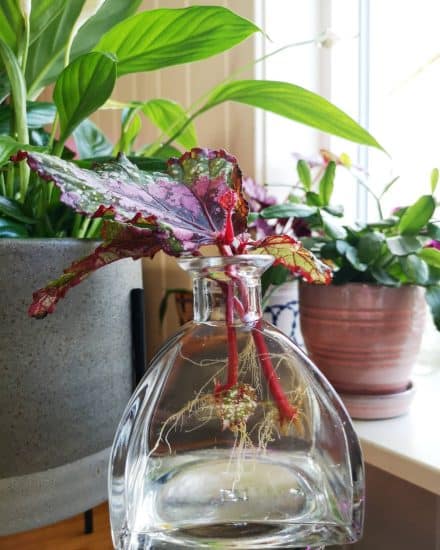
You can propagate Rex begonias in three different ways — by rhizomatous division, stem and leaf cuttings, or seed.
For all methods, the best time to propagate is during the spring before the flowers emerge.
- Rhizomatous division is the simplest and most effective way to propagate this species. It allows you to create multiple plants at once, ensure the inheritance of the same characteristics, and, bonus, prevent your plant from becoming root-bound in the process.
- Stem and leaf cutting might be a more familiar method for some people. You can even take a whole uncut Begonia leaf and wedge a 2 to 3-inch section of its stem into soil.
We’ll go over rhizome division here. If you’re interested in learning about other methods, the University of Florida has a stellar guide to stem and leaf prop that includes helpful photos.
To propagate Begonia rex by rhizome division:
- Start by watering the soil 24 hours before.
- Gently brush away some soil to access the rhizome.
- Use a sterilized pair of shears or scissors to cut a section of rhizome about 1 to 2 inches long, making sure it includes at least one growing bud or leaf stem base.
- Remove leaves from the rhizome division.
- Transplant the Rex begonia into a small pot with the same soil mix you used for the mother plant. Place it in a location that gets bright, indirect light, and try to keep the soil moist for a few weeks.
- Within 6 weeks of propagating, your Begonia Rex should have taken root and you can begin treating it like a healthy specimen. And that’s it, you’ve done it!
You know how to make more stunning Rex begonias for yourself and others, so let’s dive into how to handle common issues like brown leaves or drooping foliage.
Common issues

Taking care of a Begonia rex can sometimes feel like a balancing act, but with a few easy tips and a bit of love, your plant will be cheerful and blooming in no time.
Wilting Leaves: Lots of potential causes, so we’ll have to sleuth a bit. First, check the soil. If it’s staying wet for weeks at a time, you’ll need to water less frequently and inspect the roots to make sure they’re healthy. If the soil is dry, water it immediately and see if the plant perks right back up.
Otherwise, it’s time to check humidity, and if that passes you’ll need to adjust light. I know, a lot of potential causes. Make sure to look out for curling leaves or leaf edges burning because this is usually caused by direct sun.
Yellowing Leaves: If you notice yellow leaves and slower growth, this i typically a sign of root rot which we’ll cover in the next section. If you notice also brown leaf tips this could be over-fertilization, and if it’s crispy all over you’ll want to increase both water and humidity.
Slow Growth: Begonias need to have their leaves cleaned regularly to keep dust from building up and preventing your plant from photosynthesizing. Aim to clean the top of its leaves with a damp cloth once a month or so to clear away any debris, but make sure they don’t stay wet.
Leaf Drop: Too much or too little light can also cause leaf or leaf bud drop. When a Begonia Rex’s environment is inconsistent or not suitable in terms of light levels, the plant will naturally shed foliage to minimize stress and conserve energy.
A watchful eye and quick reactions to signs of potential issues will keep your Begonia rex healthy and radiant!
Diseases and pests
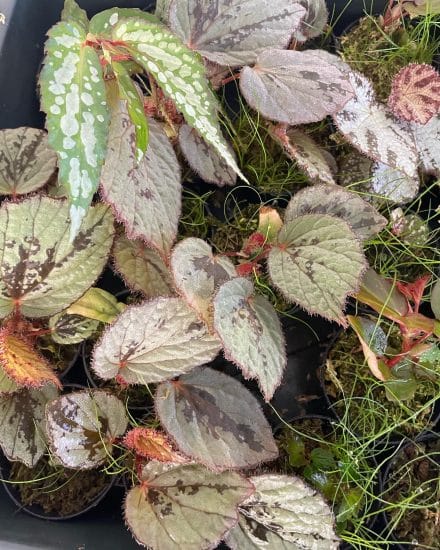
Caring for Begonia rex is a labor of love that requires watching out for uninvited guests like diseases and pests. If you find any, don’t worry — there are things you can do to protect your darling.
Fungal Infections: A common issue with Begonia rex is a type of fungus known as “powdery mildew.” There are many separate fungi that cause this, but typically this appears from keeping your leaves or soil a bit too wet. You’ll see it as white/gray powdery spots. Prune away any affected leaves, improve airflow, and try to avoid getting water directly on the leaves. Can treat with a plant fungicide.
Root Rot: If your plant’s leaves are yellowing and wilting and the soil is wet, this may be a sign of root rot. You’ll need to inspect the roots and if they seem slimy or mush cut them off (sterilize scissors or knife after) and repot in fresh soil and pot. Your old pot can be left out in the sun to bake a while before using it again.
Make sure to use a faster-draining soil (you can add perlite to the bottom, and check for drainage holes as well) and let that soil dry out before watering again.
Pests: Two common uninvited guests that might target Begonia rex are mealybugs and spider mites. Inspect your plant regularly for small white bugs or webs. If you see them, isolate the affected plant and treat it with a soapy water solution.
If a pest inspection reveals a full-on infestation, reach for the neem oil. Dilute it with water and spray it on your plant, as this will suffocate the pests within minutes. Use caution here, and always test a small area before fully covering the plant in neem oil. In addition, remove any infected leaves immediately.
Conclusion

With its wide variety of colorful foliage and undemanding maintenance requirements, owning a Begonia rex is like having a work of art in your home.
If you’d like to keep your Rex begonia looking as magnificent as it can, then you’ll have to start by getting the right potting mix (porous) and pot (shallow). It’s also important to maintain a steady humidity level of around 50%, as well as an ideal daytime temperature of around 65 to 75 degrees Fahrenheit.
Of course, regular feeding and keeping the plant moist without overwatering are also essential.
Maybe you can develop your own Begonia rex cultivar one day, but barring that, you can at least enjoy the thousands currently in existence. Collect them all! Or . . . just a few.
If you enjoyed this article, feel free to share it with a fellow Begonia rex fan. Get in touch any time with plant questions — we’re happy to hear from you.
FAQ
How do you take care of a Begonia rex?
Water Rex begonias when the first two inches of soil are dry, give them bright indirect light, keep them in moist soil, and give it normal household temperature and moderate to high humidity levels.
Is Begonia rex an indoor plant?
You can definitely grow this plant indoors! In fact, that’s the easiest way to control its ideal environmental needs.
Is Begonia rex hard to care for?
While you can’t ignore it for a month and expect it to thrive, Begonia rex care isn’t hard at all when you know how much light and water it needs, the temperature and humidity it thrives in, and the type of soil it prefers.
How long do Rex begonias last?
These plants usually last anywhere from 2 to 3 years, but don’t worry—the magic of rhizomatous begonias mean they’re super easy to propagate, and you’ll never find yourself lacking a whole new plant.
Sources
- https://www.missouribotanicalgarden.org/PlantFinder/PlantFinderDetails.aspx?taxonid=242218&isprofile=0&
- https://powo.science.kew.org/taxon/urn:lsid:ipni.org:names:105573-1
- https://www.rhs.org.uk/plants/101666/i-begonia-rex-i-(r)/details
- https://www.rhs.org.uk/plants/pdfs/agm-lists/agm-ornamentals.pdf
- https://edis.ifas.ufl.edu/publication/EP632
- https://www.aspca.org/pet-care/animal-poison-control/toxic-and-non-toxic-plants/rex-begonia

